Durability of Glass Fiber Reinforced Cement (GRC) Containing a High Proportion of Pozzolans
Abstract
:1. Introduction
2. Materials and Methods
2.1. Materials
2.2. Conditioning of Pozzolans
2.3. Preparation of GRC Specimens
2.4. Curing and Aging Methods
- (1)
- Curing composites. For the physical and chemical attack tests, specimens were subjected to two different curing processes: a) standard curing (SC) for 28 days in a humid chamber at 20 ± 1 °C and 90% relative humidity; b) to accelerate pozzolanic reactions, accelerated curing (Acc) was carried out (7 days at 20 °C and 21 days of immersion in water at 55 °C);
- (2)
- Accelerated aging. Specimens were previously cured under standard conditions and placed in a thermostatic water bath at 55 °C for 28 days (SC+Ag). The equivalence in predictive durability terms is, according to Purnell et al. [24], 100 days at 20 °C and in a humid environment (UK conditions) for each aging day, which would amount to about 8 aging years under standard conditions.
2.5. Testing Procedures
- (1)
- Water absorption and dry density. To determine the percentage of water absorption by immersion and dry density, the procedure described in Standard UNE-EN 1170-6: 1998 [25] was followed. Six specimens were measured for each GRC type and treatment;
- (2)
- A four-point bending test (10 × 50 × 225 mm specimens, load rate 0.03 ± 0.003 mm/s) was performed in accordance with European Standard EN 1170-5 [23] to calculate the composites’ modulus of rupture (see Equation (1)) and toughness (computed as the area under the load-displacement curve until the load drops to 10% of FMOR).
- (3)
- Electronic scanning microscopy (SEM, JEOL JSM6300), equipped with energy dispersive X-ray (EDS: Link-Isis, Oxford Instruments, Oxford, UK) for microanalyses, was used to observe fiber deterioration. The acceleration voltage was 20 kV and the samples were covered with carbon. AR glass fibers were subjected to different aggressive reagents and heat treatment in aqueous medium between 28 and 70 days at 55 °C by immersion in saturated Ca(OH)2 and 5% NaOH solutions. After exposure, fiber deterioration was analyzed by SEM.
- (4)
- Wetting–drying cycles. Specimens were subjected to wetting–drying cycles according to Standard UNE-ENV 1170-8:1997 [26], and were immersed for 24 h in either deionized water or a solution with 3.5% NaCl. Next, they were dried in a ventilated oven at 60 °C for 23 h. When removed from the oven, they were allowed to cool for 1 h. This cycle was repeated 10, 25, and 50 times for both the specimens saturated with water and those saturated with the NaCl solution to monitor the mass of each specimen at the end of every cycle. Six specimens were measured for each GRC type and treatment;
- (5)
- A thermogravimetric analysis (TGA 850 Mettler-Toledo, Greifensee, Switzerland) was carried out on pastes to assess the calcium hydroxide content and combined water in the cementing products. Samples were subjected to a heating ramp of 10 °C/min from 35 °C to 600 °C using a sealed aluminum crucible with a pinhole. The test atmosphere was nitrogen, fed at a rate of 75 mL/min;
- (6)
- Freeze–thaw cycles. Specimens were subjected to freezing–thawing according to ASTM C 1185-03, Section 12, “Freeze-Thaw-Cladding Products” [27]. Next, specimens were frozen at −20 °C for 2 h before being submitted to the thawing process at 20 °C for 2 h immersed in water. This cycle was repeated 50 and 100 times. A visual record and monitoring the mass of each specimen were carried out at the end of every cycle. Six specimens were measured for each GRC type and treatment;
- (7)
- Exposure to chemically aggressive agents. After specimens underwent the curing and aging processes, they were immersed in different aggressive solutions: 1 M solution of ammonium chloride (NH4Cl) at 20 °C and 0.5 M of sulfuric acid (H2SO4) at 20 °C. A visual record was made and the mass evolution of each specimen was recorded periodically by controlling the changes in the pH of each solution, which varied constantly as an effect of the interaction between acid solutions and alkaline composites. The NH4Cl solution was changed when pH reached 9, as was the H2SO4 solution when it reached 1.5. Six specimens were measured for each GRC type and treatment.
3. Results and Discussion
3.1. Characterization of Composites and Their Evolution by Aging
3.1.1. Water Absorption and Dry Density
3.1.2. Mechanical Behavior of the Aged GRC Composites
3.1.3. Exposing AR Fibers to Different Aggressive Environments
3.2. Evaluation of the Composites’ Behavior Subjected to Physical Attacks
3.2.1. Wetting–Drying in Water
3.2.2. Wetting–Drying in 3.5% NaCl Solution
3.2.3. Freeze–Thaw Attack
3.3. Assessment of the Behavior of the GRC Composites Subjected to Chemical Attacks
3.3.1. Exposing the GRC Composites to a NH4Cl Solution
3.3.2. Exposing the GRC Composites to a H2SO4 Solution
4. Conclusions
Author Contributions
Funding
Institutional Review Board Statement
Informed Consent Statement
Data Availability Statement
Acknowledgments
Conflicts of Interest
References
- Bijen, J. Durability of some glass fiber reinforced cement composites. J. Proc. 1983, 80, 305–311. [Google Scholar]
- Purnell, P.; Short, N.R.; Page, C.L.; Majumdar, A.J. Microstructural observations in new matrix glass fibre reinforced cement. Cem. Concr. Res. 2000, 30, 1747–1753. [Google Scholar] [CrossRef]
- Yilmaz, V.T.; Lachowski, E.E.; Glasser, F.P. Chemical and microstructural changes at alkali-resistant glass fiber-cement interfaces. J. Am. Ceram. Soc. 1991, 74, 3054–3060. [Google Scholar] [CrossRef]
- Zhang, Y.; Sun, W.; Shang, L.; Pan, G. Effect of high content of fly ash on the properties of glass fiber reinforced cementitious composites. Cem. Concr. Res. 1997, 27, 1885–1891. [Google Scholar] [CrossRef]
- Marikunte, S.; Aldea, C.; Shah, S.P. Durability of glass fiber reinforced cement composites: Effect of silica fume and metakaolin. Adv. Cem. Bas. Mat. 1997, 5, 100–108. [Google Scholar] [CrossRef]
- Orlowsky, J.; Raupach, M.; Cuypers, H.; Wastiels, J. Durability modelling of glass fibre reinforcement in cementitious environtment. Mater. Struct. 2005, 38, 155–162. [Google Scholar] [CrossRef]
- Schorm, H.; Schiekel, M. Prediction of lifetime of alkali-resistant glass fibres in cementitious concretes. In Proceedings of the 6th RILEM Symposiun on Fibre-Reinforced Concrete BEFIB, Varenna, Italy, 20–22 September 2004; pp. 615–624. [Google Scholar]
- Payá, J.; Bonilla, M.; Borrachero, M.V.; Monzó, J.; Peris-Mora, E.; Lalinde, L.F. Reusing of fly ashes in glass fibre reinforced cement: A new generation of high-quality GRC composites. Waste Manag. 2007, 27, 1416–1421. [Google Scholar] [CrossRef]
- Leonard, S.; Bentur, A. Improvement of the durability of glass fiber reinforced cement using blended cement matrix. Cem. Concr. Res. 1984, 14, 717–728. [Google Scholar] [CrossRef]
- Hsu, S.; Chi, M.; Huang, R. Effect of fineness and replacement ratio of ground fly ash on properties of blended cement mortar. Constr. Build. Mater. 2018, 176, 250–258. [Google Scholar] [CrossRef]
- Feng, J.; Sun, J.; Yan, P. The influence of ground fly ash on cement hydration and mechanical property of mortar. Adv. Civ. Eng. 2018, 2018, 4023178. [Google Scholar] [CrossRef] [Green Version]
- Yajun, J.; Cahyadi, J.H. Effects of densified silica fume on microstructure and compressive strength of blended cement pastes. Cem. Concr. Res. 2003, 33, 1543–1548. [Google Scholar] [CrossRef]
- Martínez-Velandia, D.; Payá, J.; Monzó, J.; Borrachero, M.V. Effect of sonication on the reactivity of silica fume in Portland cement mortars. Adv. Cem. Res. 2011, 23, 23–31. [Google Scholar] [CrossRef] [Green Version]
- Enfedaque Díaz, A.; Sánchez Paradela, L.V.; Sánchez-Gálvez, V. The effect of silica fume and metakaolin on glass-fibre reinforced concrete (GRC) ageing. Mater. Constr. 2010, 60, 67–82. [Google Scholar]
- Melgarejo, R.C.G. Mitigation of aging of glass fiber reinforced cement (GRC) using pozzolan and acrylic resin additions. In Proceedings of the International Congress of Innovation and Trends in Engineering (CONIITI), Bogotá, Colombia, 2–4 October 2019. [Google Scholar] [CrossRef]
- Enfedaque, A.; Alberti, M.G.; Galvez, J.C.; Mengie, S. Influence of Natural Weather Conditions in the Long-Term Fracture Energy of Glass Fibre Reinforced Cement (GRC) Modified with Chemical Additions. Materials 2021, 14, 3355. [Google Scholar] [CrossRef]
- Cheng, C.; He, J.; Zhang, J.; Yang, Y. Study on the time-dependent mechanical properties of glass fiber reinforced cement (GRC) with fly ash or slag. Constr. Build. Mater. 2019, 217, 128–136. [Google Scholar] [CrossRef]
- Genovés, V.; Gosálbez, J.; Miralles, R.; Bonilla, M.; Payá, J. Ultrasonic characterization of GRC with high percentage of fly ash substitution. Ultrasonics 2015, 60, 88–95. [Google Scholar] [CrossRef]
- Butler, M.; Hempel, S.; Mechtcherine, V. Modelling of ageing effects on crack-bridging behaviour of AR-glass multifilament yarns embedded in cement-based matrix. Cem. Concr. Res. 2011, 41, 403–411. [Google Scholar] [CrossRef]
- Ayadi, A.; Palou, M.; Iratni, A. Silica fume treatment for improving durability of alkali resistant glass fibres in cement matrixes. Solid State Phenom. 2003, 90, 209–214. [Google Scholar] [CrossRef]
- Martínez-Velandia, D.; Payá, J.; Monzó, J.; Borrachero, M.V. Granulometric activation of densified silica fume (CSF) by sonication. Adv. Cem. Res. 2008, 20, 129–135. [Google Scholar] [CrossRef]
- Payá, J.; Monzó, J.; Borrachero, M.V.; Peris-Mora, E. Mechanical treatment of fly ashes. Part I: Physico-chemical characterization of ground fly ashes. Cem. Concr. Res. 1995, 25, 1469–1479. [Google Scholar] [CrossRef]
- UNE-EN 1170-5:1998; Productos Prefabricados de Hormigón. Método de Ensayo para Hormigón Armado con Fibra de Vidrio. Medida de la Resistencia a Flexión, Método Denominada Ensayo Completo a Flexión; Aenor: Madrid, Spain, 1998. (In Spanish)
- Purnell, P.; Short, N.R.; Page, C.L. A static fatigue model for the durability of glass fibre reinforced cement. J. Mat. Sci. 2001, 36, 5385–5390. [Google Scholar] [CrossRef]
- UNE-EN 1170-6:1998; Productos Prefabricados de Hormigón. Método de Ensayo para Hormigón Armado con Fibra de Vidrio. Determinación de la Absorción de Agua por Inmersión y Determinación de la Densidad Seca; Aenor: Madrid, Spain, 1998. (In Spanish)
- UNE-EN 1170-8:1998; Método de Ensayo para Hormigón Armado con Fibra de Vidrio. Ensayo de Tipo de Envejecimiento a la Intemperie Cíclico; Aenor: Madrid, Spain, 1998. (In Spanish)
- ASTM C1185-03; Standard Test Methods for Sampling and Testing Non-Asbestos Fiber-Cement Flat Sheet, Roofing and Siding Shingles, and Clapboards; ASTM: West Conshohocken, PA, USA, 2003.
- Guzlena, S.; Sakale, G. Self-healing of glass fibre reinforced concrete (GRC) and polymer glass fibre reinforced concrete (PGRC) using crystalline admixtures. Constr. Build. Mater. 2021, 267, 120963. [Google Scholar] [CrossRef]
- Bartos, P.J.M. Glassfibre Reinforced Concrete: A Review. IOP Conf. Ser. Mater. Sci. Eng. 2017, 246, 012002. [Google Scholar] [CrossRef]
- Nourredine, A.; Molez, L.; Rangeard, D. Durability of Alkali-resistanyt glass fiber reinforced cement composite: Microstru tural observations of degradation. Period. Polytech. Civil Eng. 2018, 2018, 10631. [Google Scholar]
- Wang, Y.; Shui, Z.; Gao, X.; Huang, Y.; Yu, R.; Song, Q. Chloride binding capacity and phase modification of alumina compound blended cement paste under chloride attack. Cem. Concr. Comp. 2020, 108, 103537. [Google Scholar] [CrossRef]
- Amin, M.; Bassuoni, M.T. Performance of concrete with blended binders in ammonium sulphate solution. J. Sustain. Cem. Based Mater. 2017, 7, 15–37. [Google Scholar] [CrossRef]
- Lun, D.; Yuan, T.; Yang, X.; Rong, H.; Shi, J.; Pan, M. Effect of fly ash onlLeaching characteristics of cement-stabilized macadam base. Materials 2021, 14, 5935. [Google Scholar] [CrossRef]
- Talero, R.; Trusilewicz, L.; Delgado, A.; Pedrajas, C.; Lannegrand, R.; Rahhal, V.; Mejía, R.; Delvasto, S.; Ramírez, F.A. Comparative and semi-quantitative XRD analysis of Friedel’s salt originating from pozzolan and Portland cement. Constr. Build. Mater. 2011, 25, 370–2380. [Google Scholar] [CrossRef]
- Wanna, S.; Toochinda, P.; Saengsoy, W.; Tangtermsirikul, S. Deterioration in sulfuric acid of cement pastes incorporating high CaO and low CaO fly ashes. Eng. J. 2021, 25, 71–83. [Google Scholar] [CrossRef]
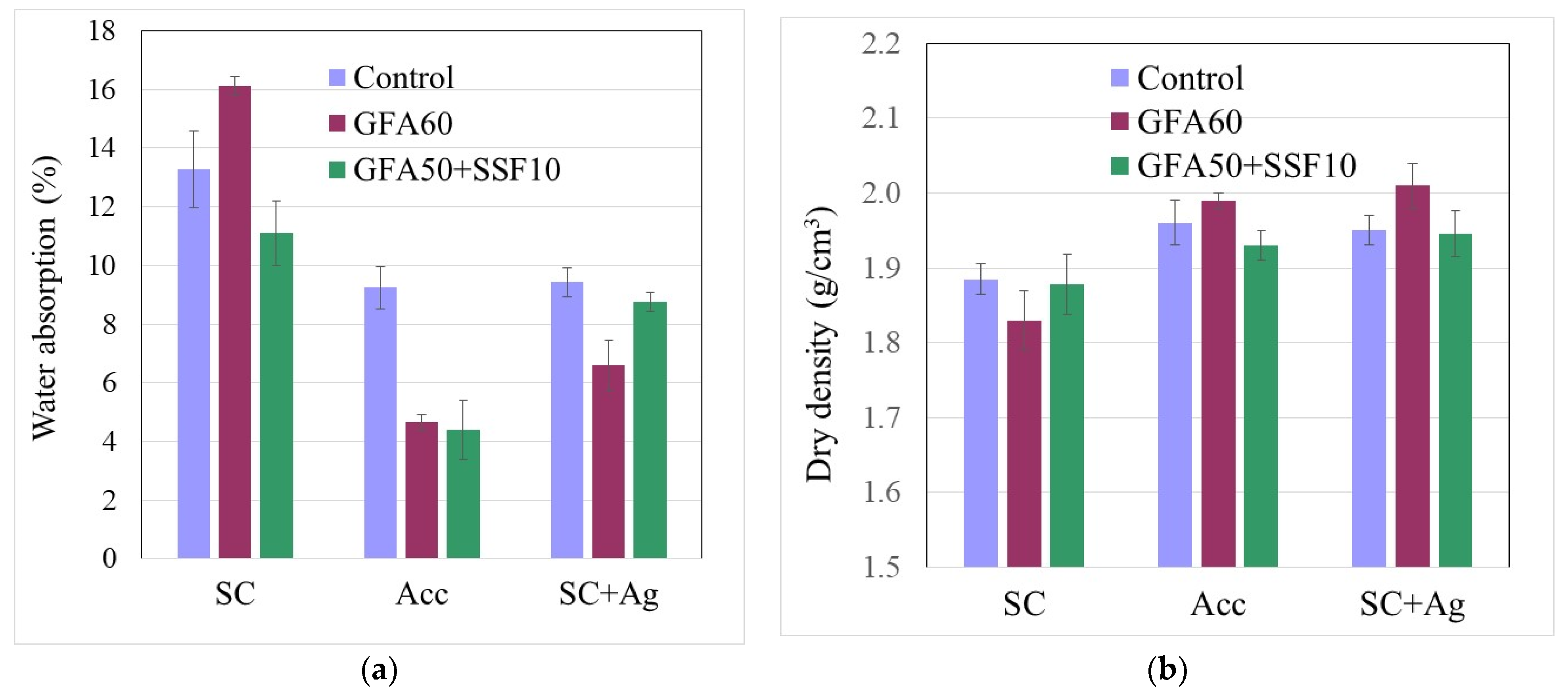
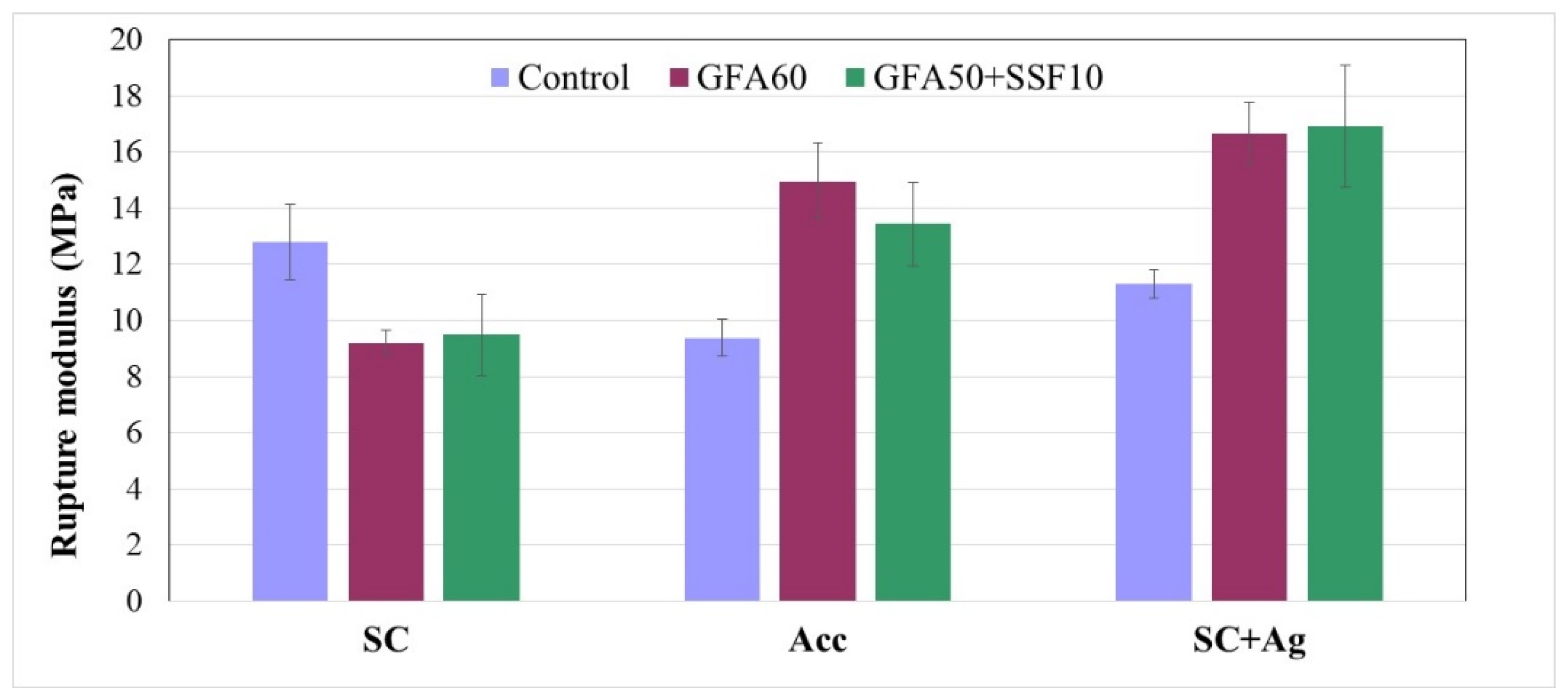
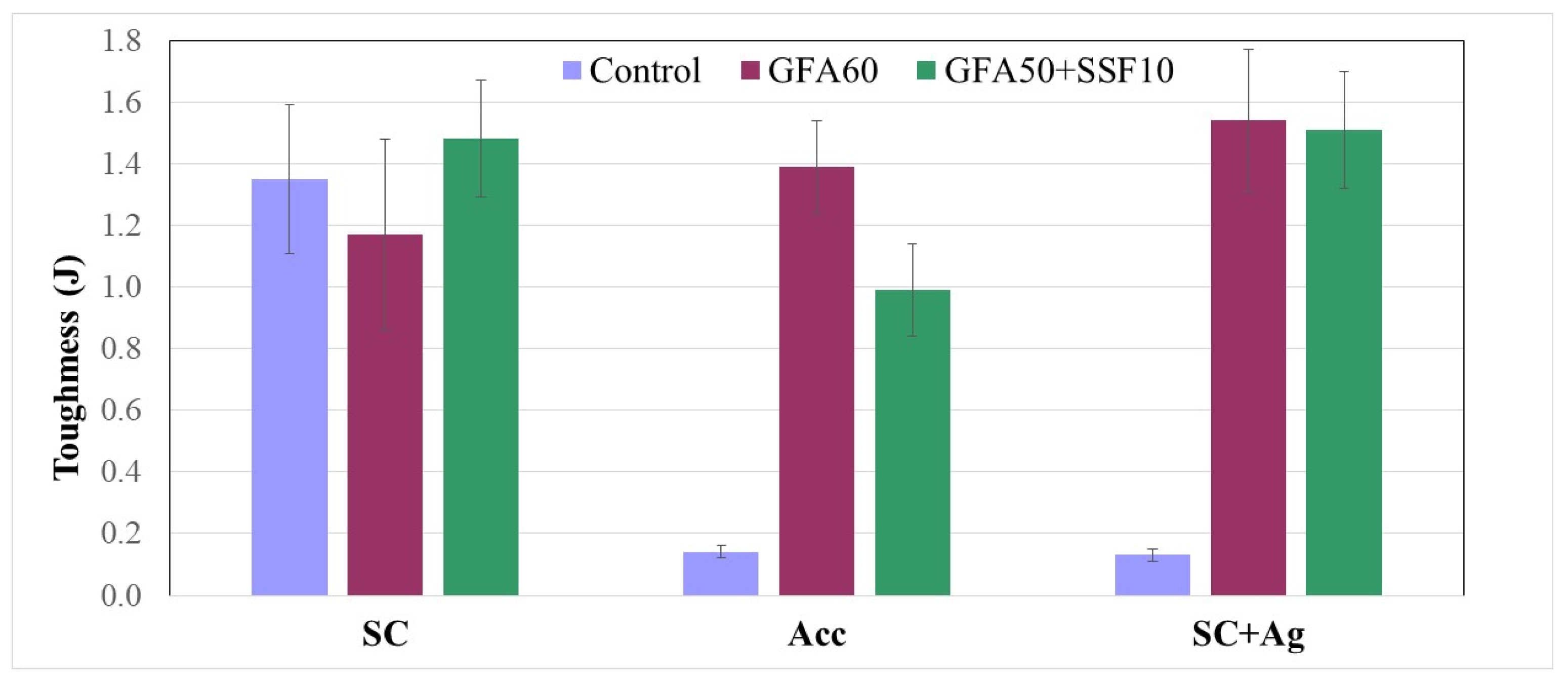



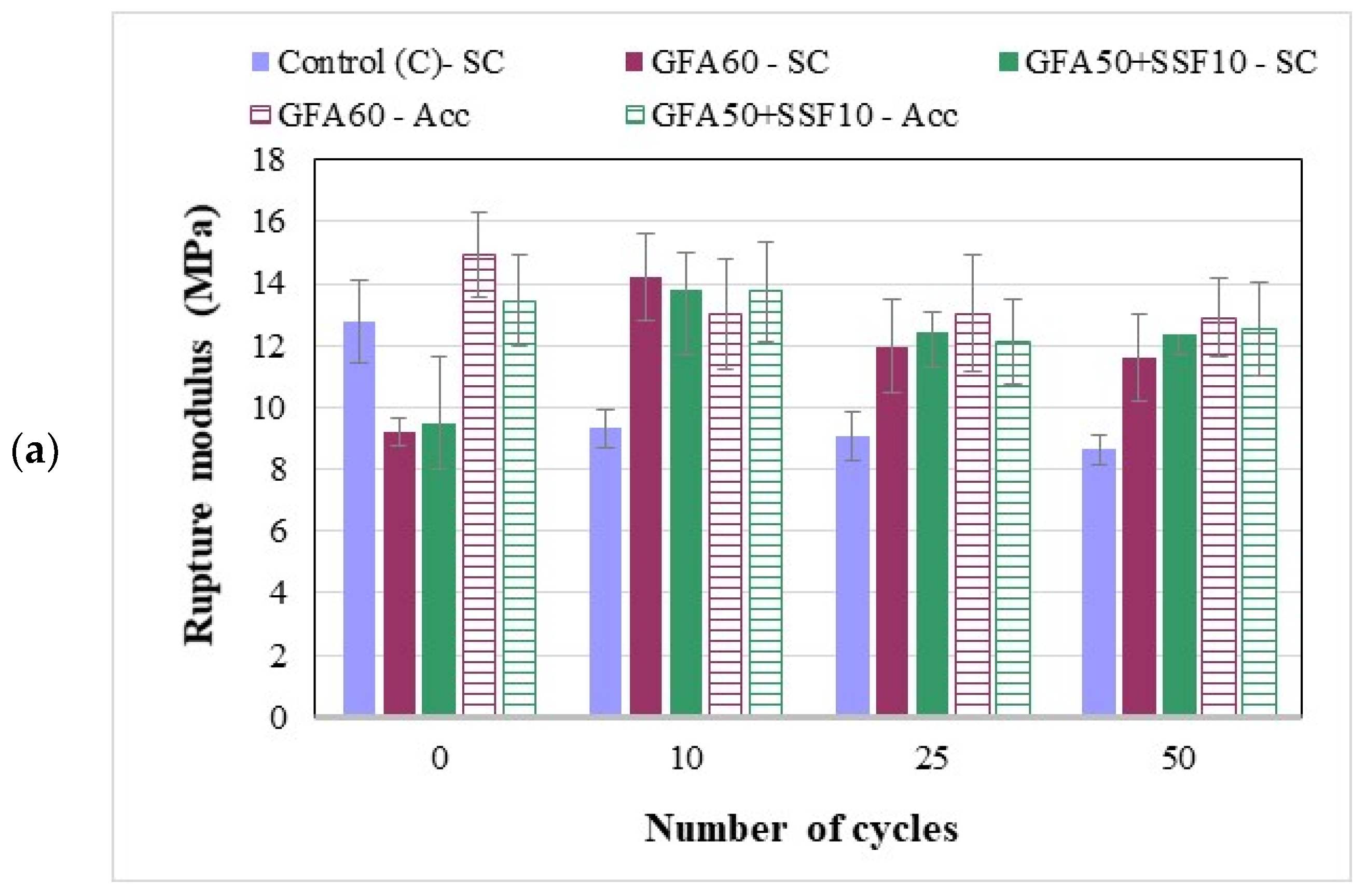
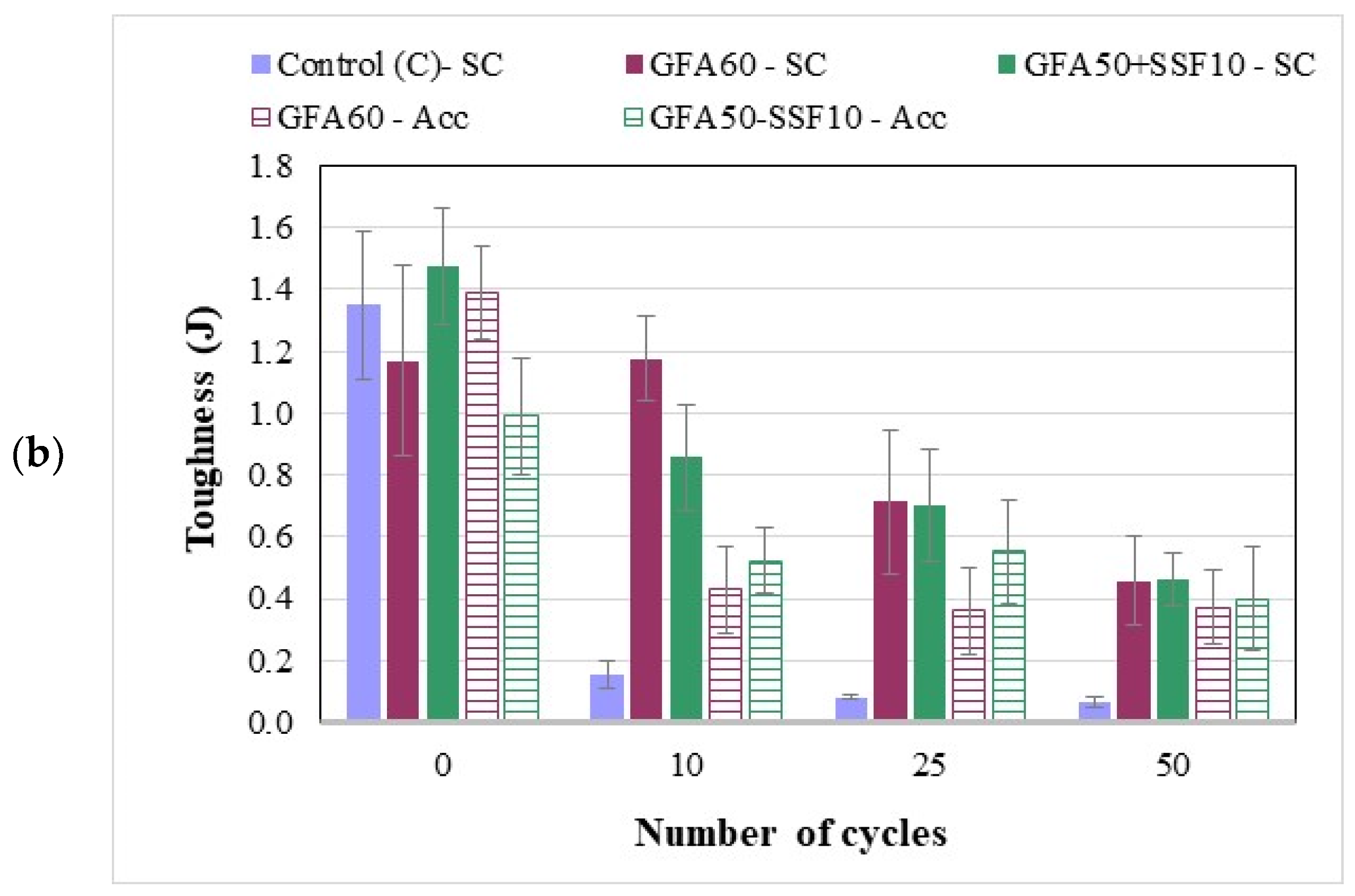
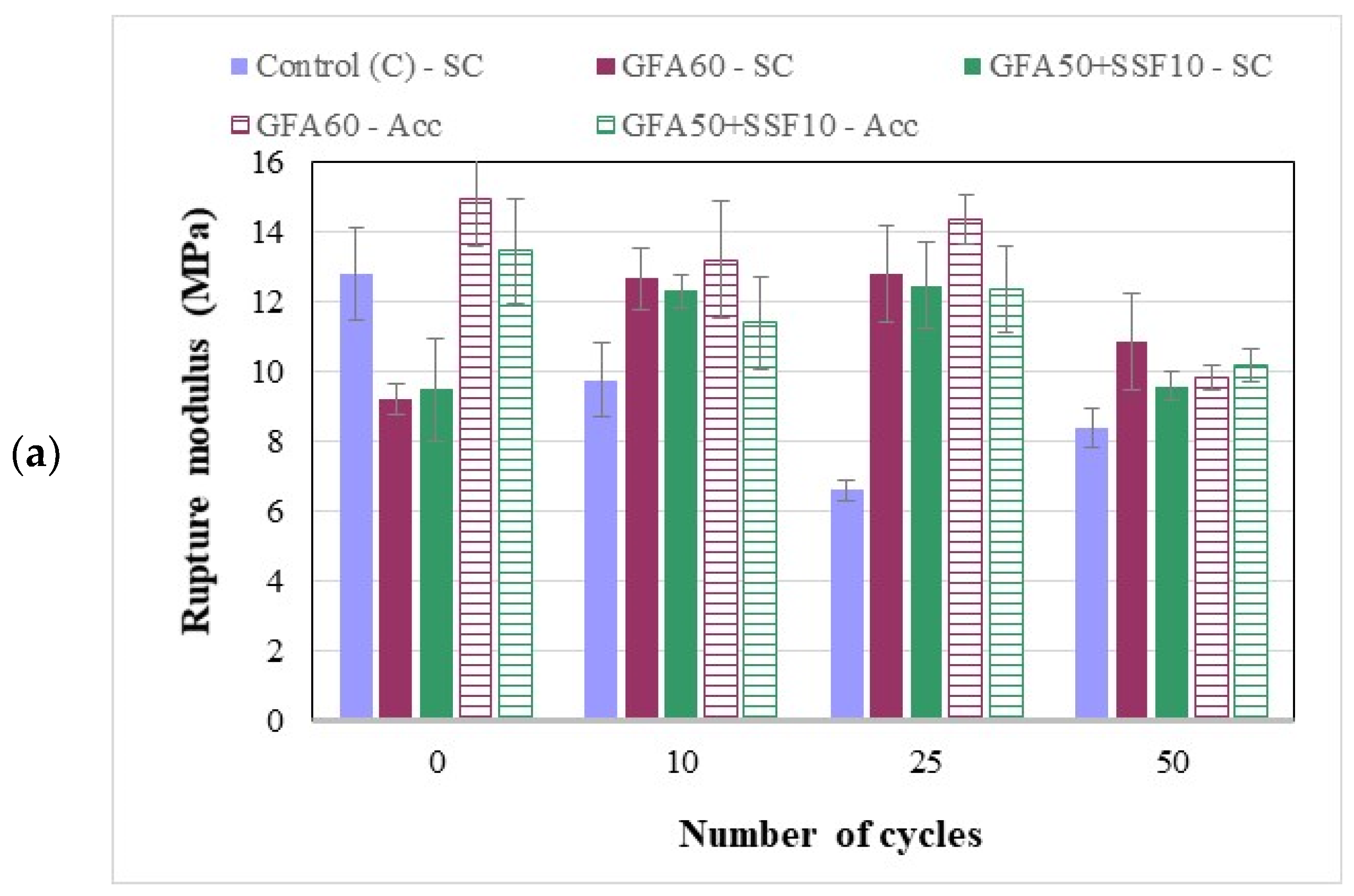
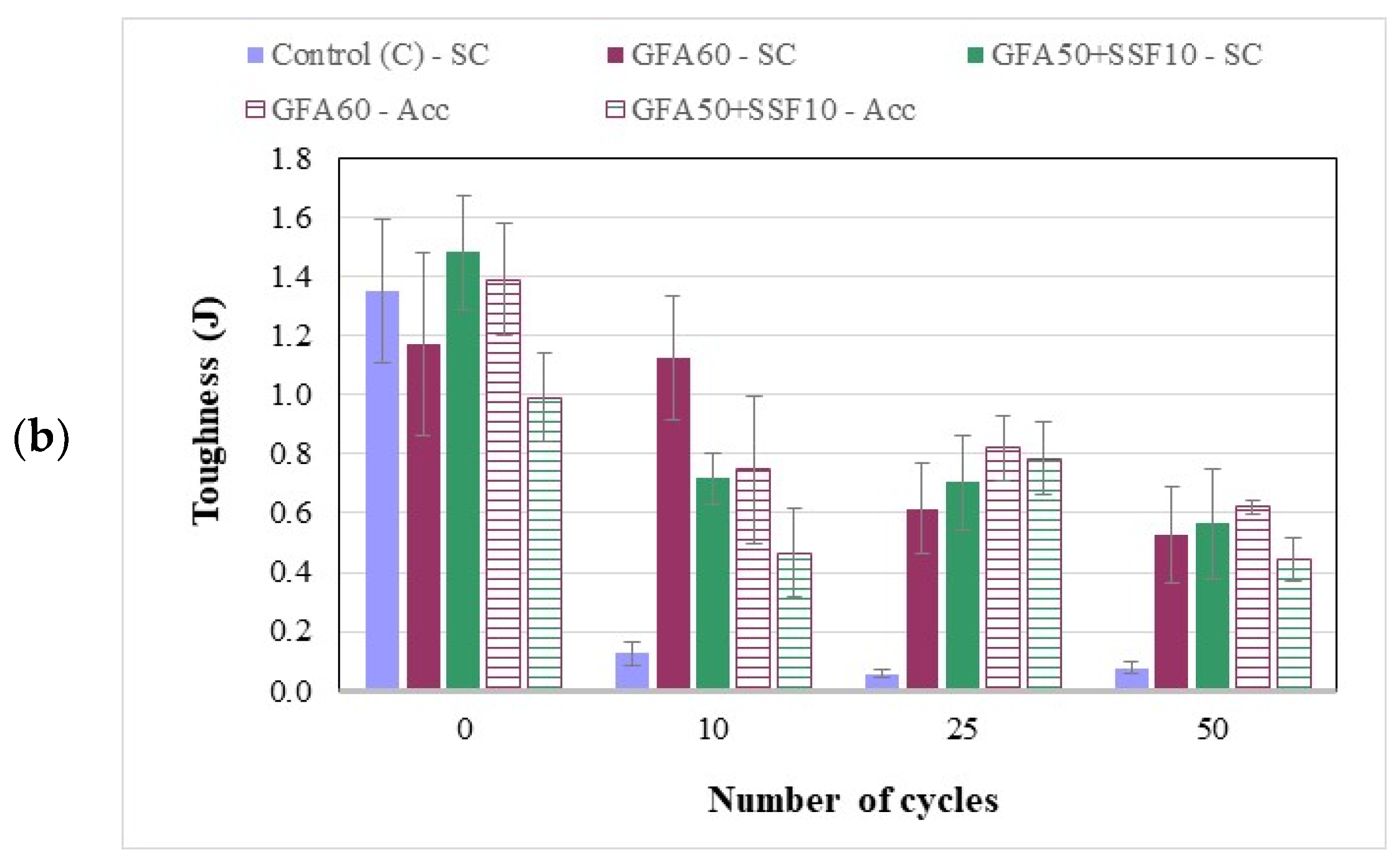

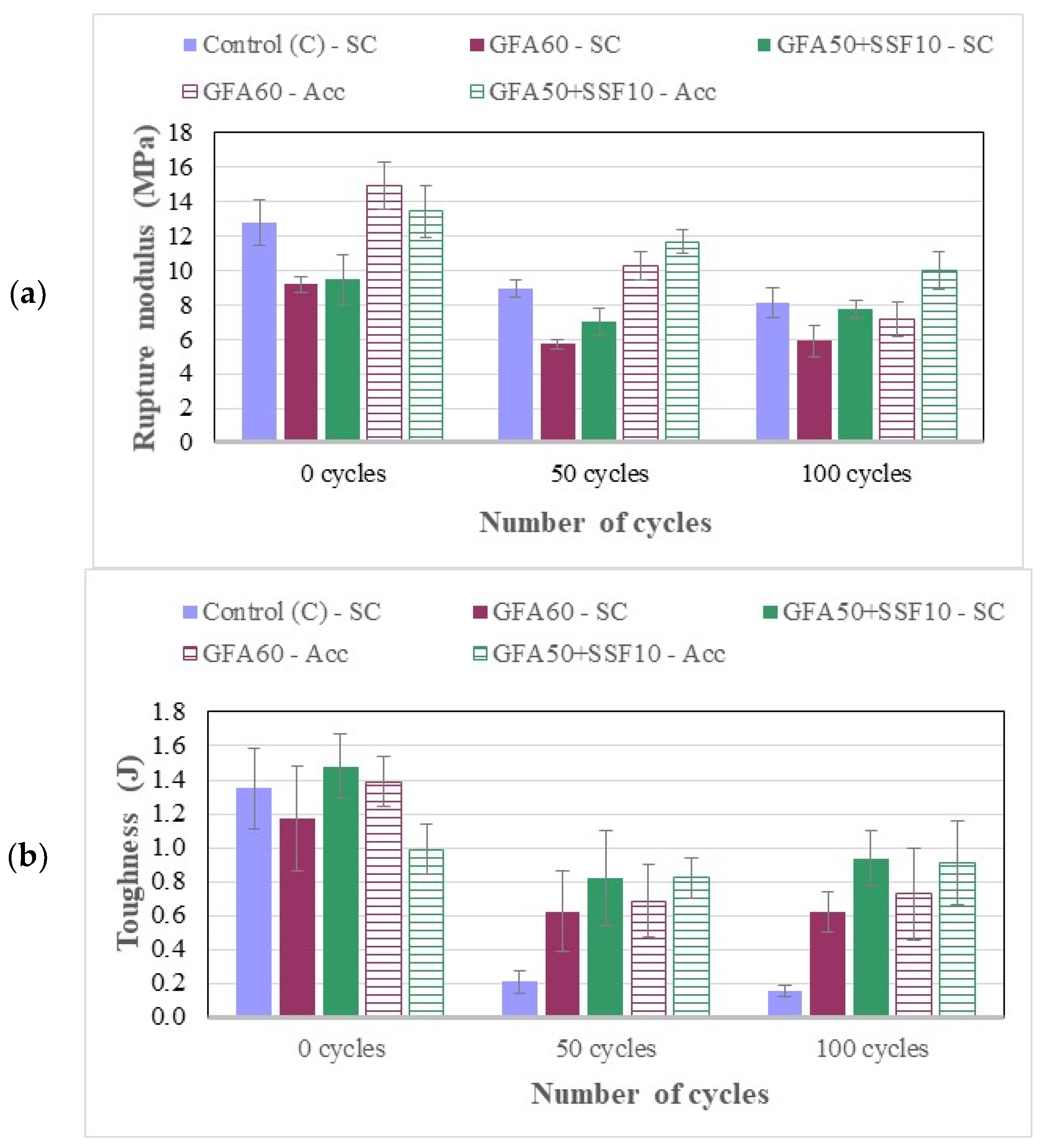
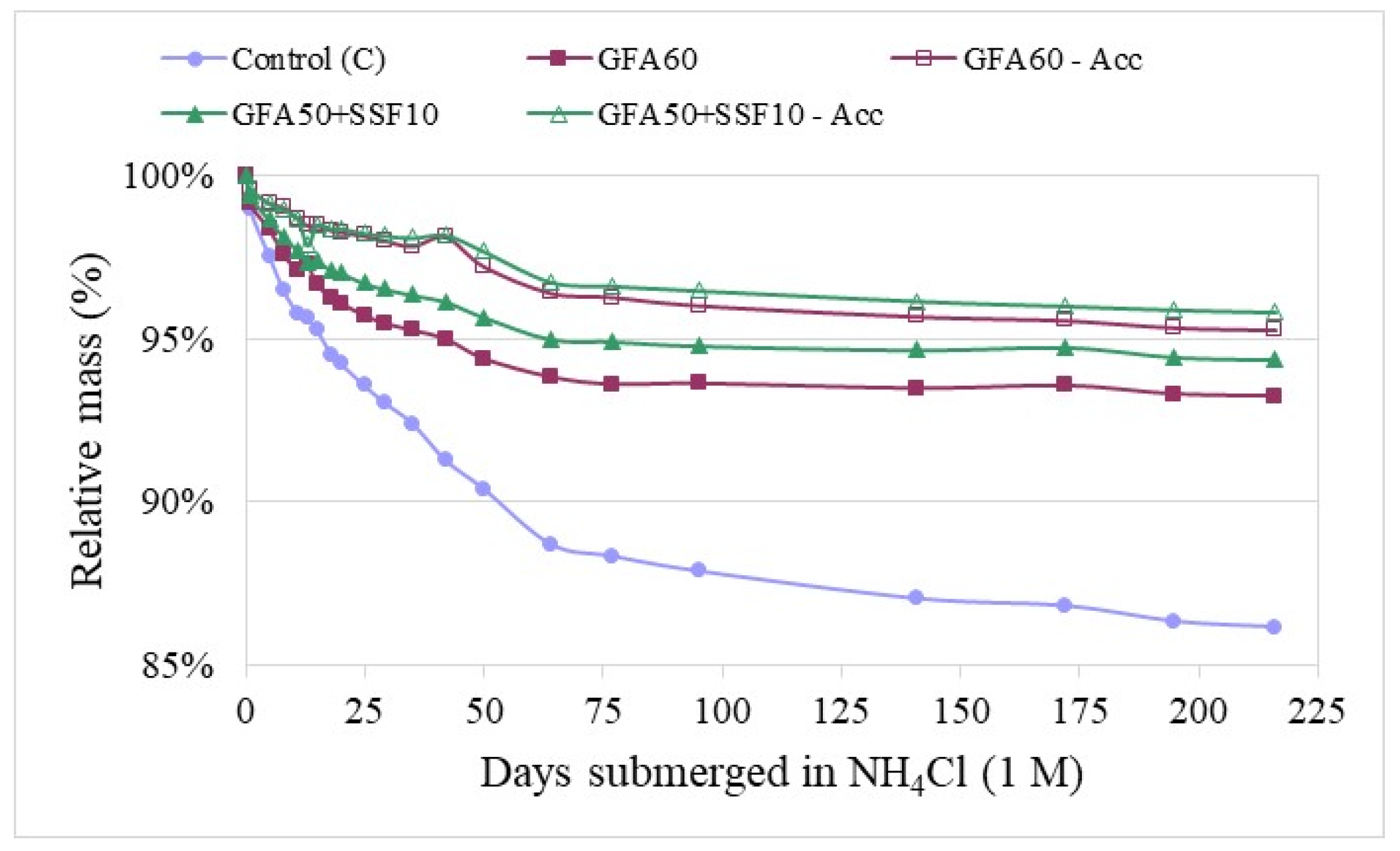

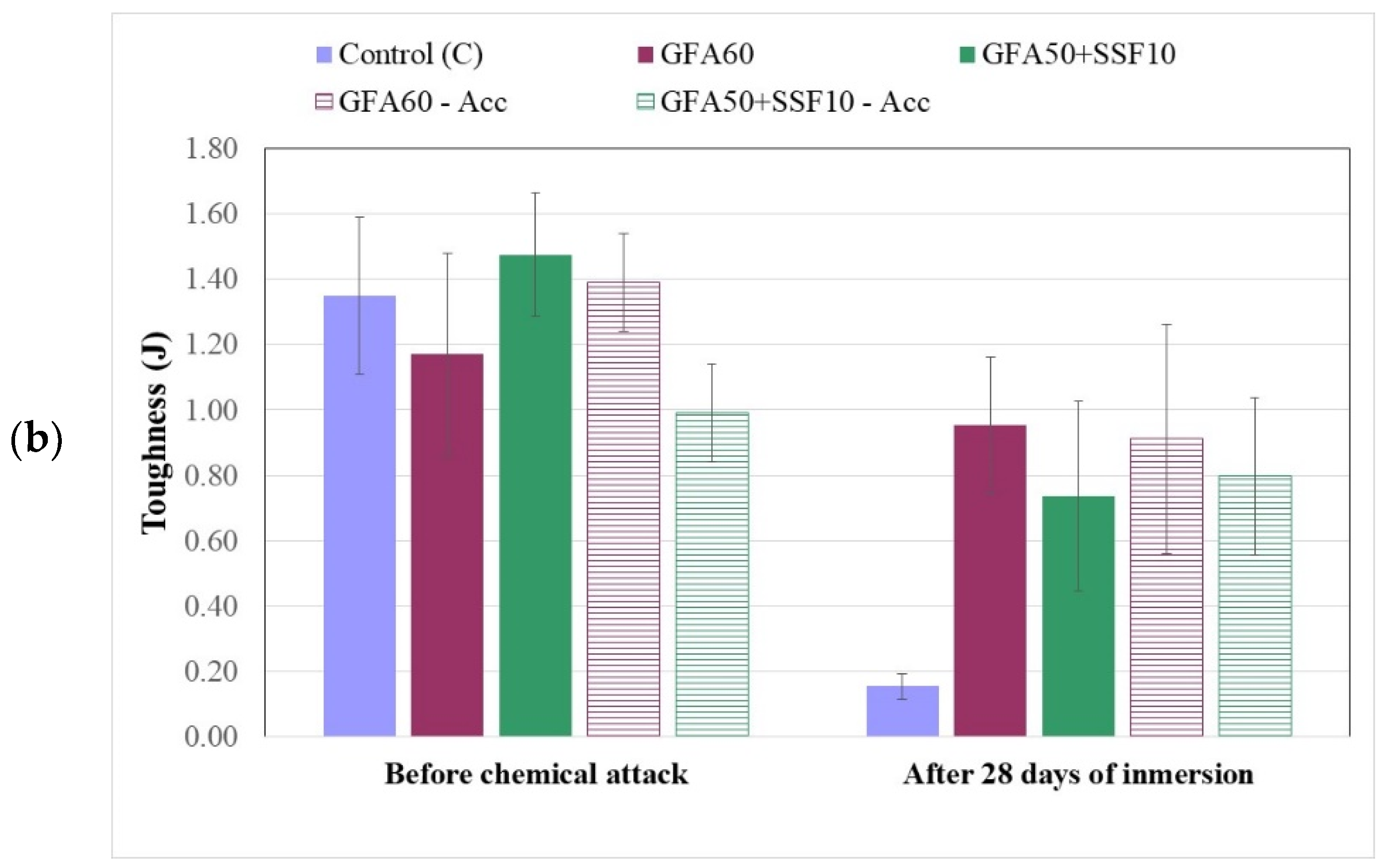
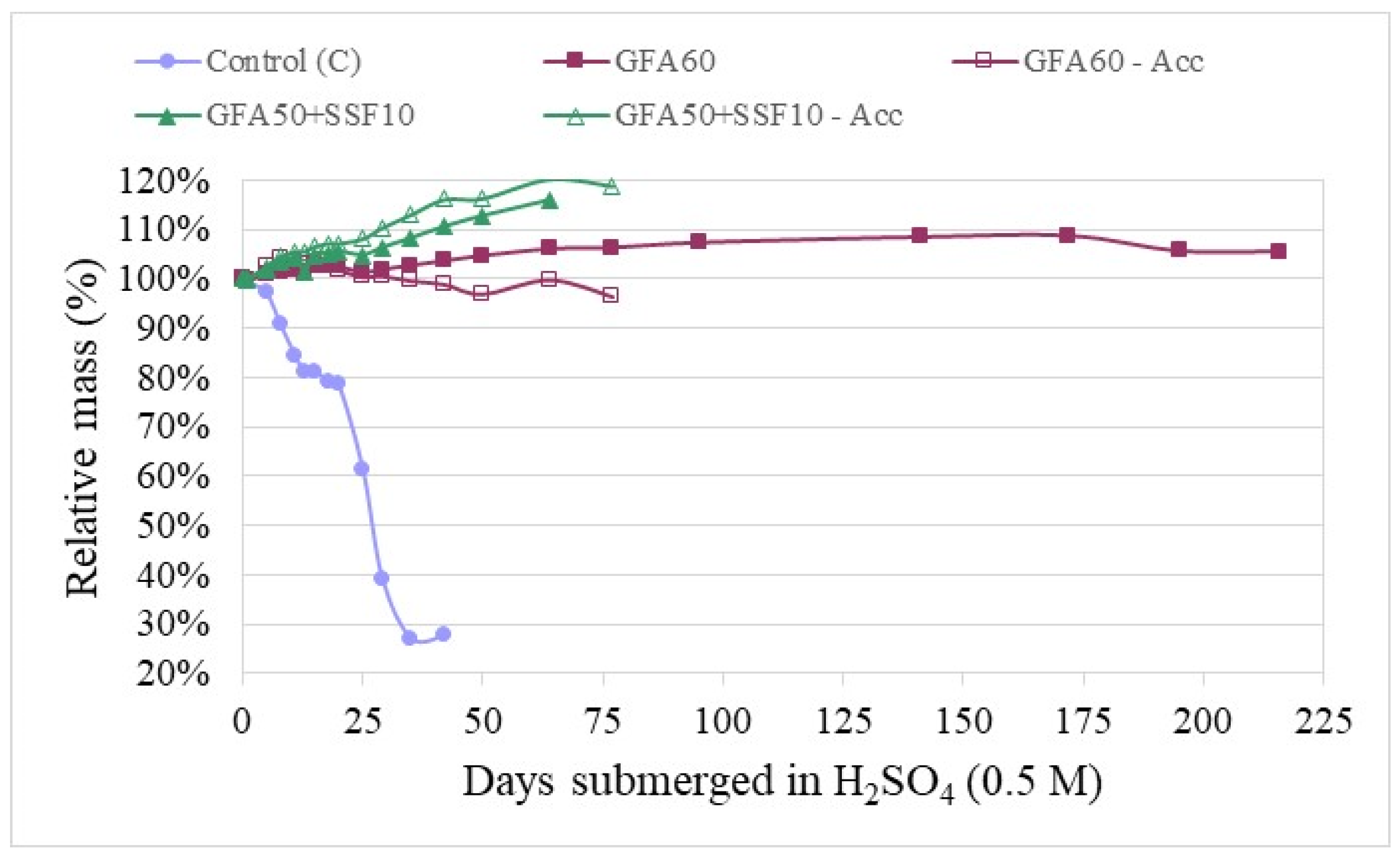
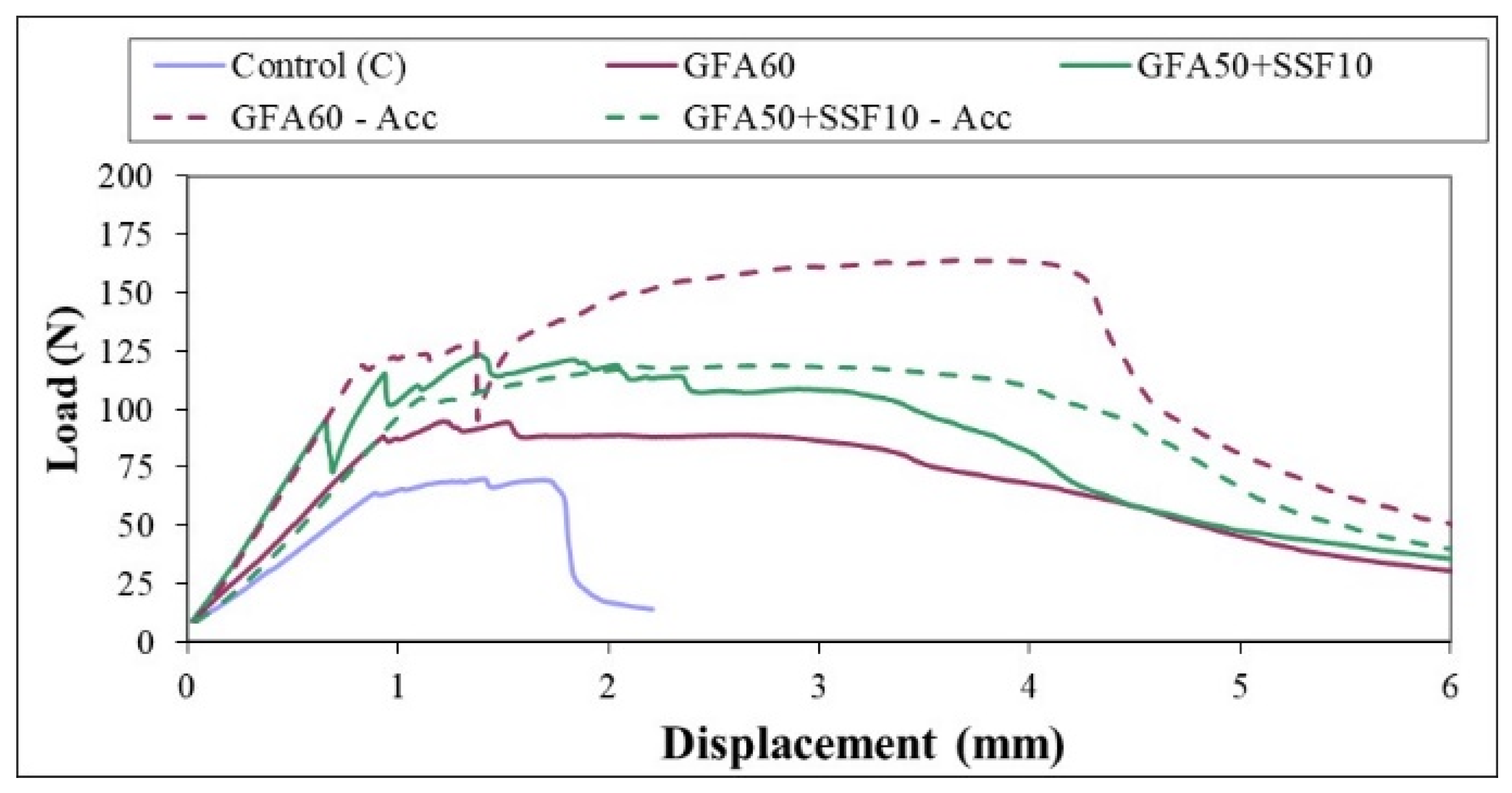
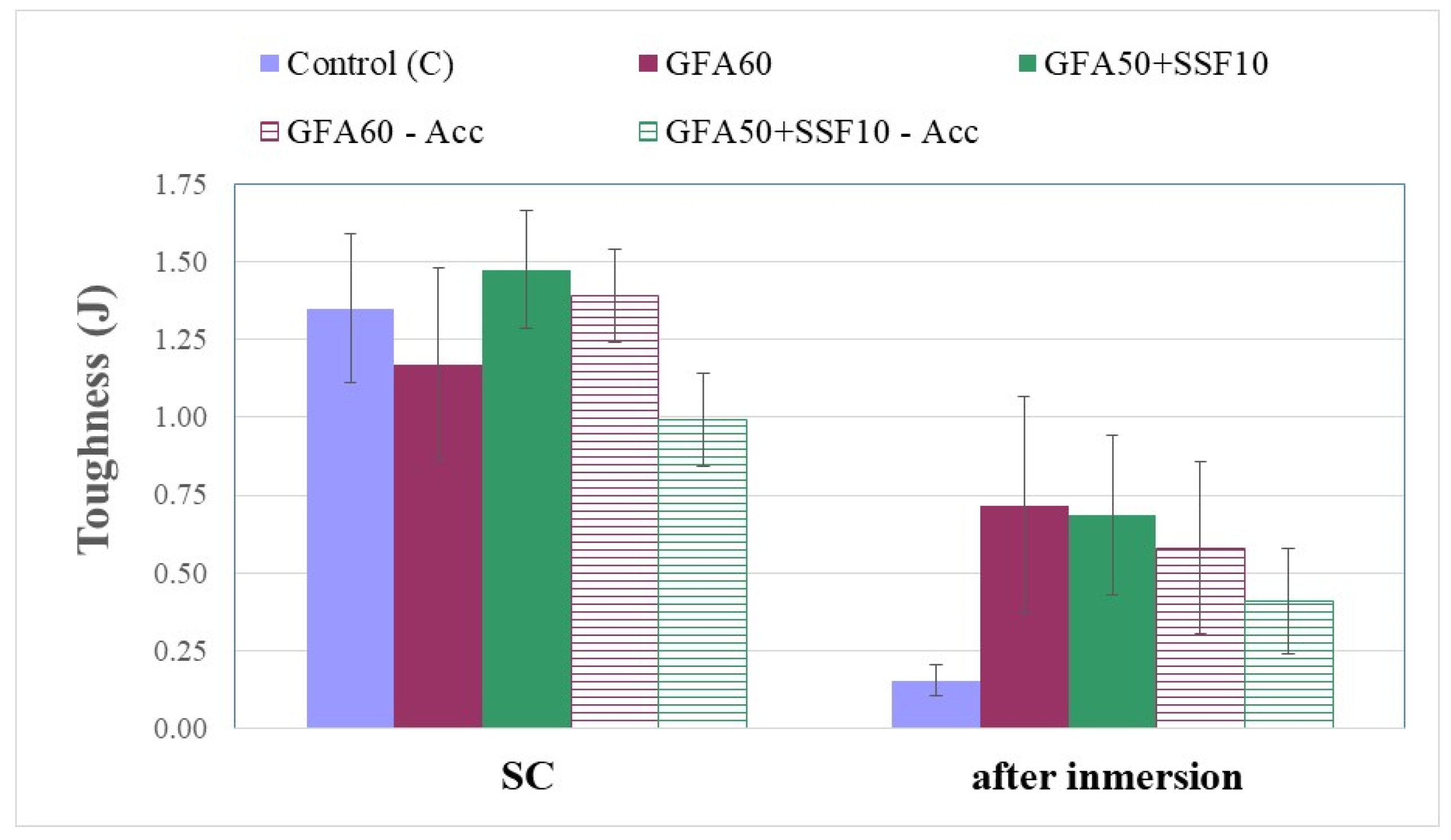
| SiO2 | ZrO2 | (Na2O, K2O) * | (CaO, MgO) ** | B2O3 | Al2O3 | TiO2 | F2 |
|---|---|---|---|---|---|---|---|
| 55–75 | 15–20 | 11–21 | 0–6 | 0–2 | 0–5 | 0–3 | 0–2 |
| Oxide | SiO2 | Al2O3 | Fe2O3 | CaO | MgO | SO3 | K2O | Na2O | LOI * |
|---|---|---|---|---|---|---|---|---|---|
| CEM I/52.5R | 22.05 | 5.44 | 3.64 | 62.53 | 2.43 | 3.75 | 1.42 | - | 1.6 |
| FA | 40.94 | 24.65 | 13.59 | 9.83 | 1.59 | 1.60 | 1.40 | 0.34 | 2.44 |
| DSF | 90.77 | 0.46 | 4.53 | 0.78 | 0.23 | 0.02 | 0.37 | 0.21 | 3.43 |
| Mean Particle Diameter (µm) | d (0.1) µm | d (0.5) µm | d (0.9) µm | |
|---|---|---|---|---|
| FA | 29.92 | 2.30 | 18.55 | 74.32 |
| GFA | 10.38 | 1.46 | 8.19 | 22.25 |
| DSF | 76.67 | 7.95 | 34.82 | 199.55 |
| SSF | 23.47 | 2.45 | 18.36 | 52.57 |
| Sample | CEM I 52.5R | Limestone Filler | Pozzolan | Siliceous Sand | AR Fiber | Superplastizicer | Mixing Water |
|---|---|---|---|---|---|---|---|
| C | 1153.7 | 384.6 | 0 | 1025.5 | 93 | 15.4 | 529.8 |
| GFA60 | 461.5 | 153.8 | 923 | 1025.5 | 93 | 12.3 | 531.6 |
| GFA50+SSF10 | 461.5 | 153.8 | 769.1 + 153.8 | 1025.5 | 93 | 20 | 527.0 |
| Spot 1 | Spot 2 | Spot 3 | |
|---|---|---|---|
| Element | Atomic% | Atomic% | Atomic% |
| O K | 77.36 | 65.23 | 76.39 |
| Na K | 0.68 | 3.00 | 0.00 |
| Mg K | 0.26 | 0.62 | 0.96 |
| Al K | 2.74 | 2.68 | 0.29 |
| Si K | 4.37 | 9.18 | 3.93 |
| S K | 0.25 | 2.11 | 0.46 |
| Cl K | 0.44 | 2.74 | 0.76 |
| K K | 0.53 | 0.10 | 0.00 |
| Ca K | 13.28 | 13.31 | 17.02 |
| Fe K | 0.10 | 0.24 | 0.07 |
| Zr L | 0.00 | 0.80 | 0.10 |
| Composite | % Combined Water from Hydrates | %Ca(OH)2 | ||
|---|---|---|---|---|
| Standard Curing 28 Days at 20 °C | After 50 Cycles | Standard Curing 28 Days at 20 °C | After 50 Cycles | |
| C | 10.27 | 12.17 | 7.98 | 4.67 |
| GFA60 | 7.39 | 12.26 | 0.00 | 0.00 |
| GFA50+SSF10 | 9.50 | 12.03 | 0.00 | 0.00 |
| Composite | % Combined Water from Hydrates | %Ca(OH)2 | ||
|---|---|---|---|---|
| Standard Curing 28 Days at 20 °C | Immersed for 28 Days in NH4Cl | Standard Curing 28 Days at 20 °C | Immersed for 28 Days in NH4Cl | |
| C | 10.27 | 13.76 * | 7.98 | 0.00 |
| GFA60 | 7.40 | 9.10 | 0.00 | 0.00 |
| GFA50+SSF10 | 9.50 | 8.30 | 0.00 | 0.00 |
Publisher’s Note: MDPI stays neutral with regard to jurisdictional claims in published maps and institutional affiliations. |
© 2022 by the authors. Licensee MDPI, Basel, Switzerland. This article is an open access article distributed under the terms and conditions of the Creative Commons Attribution (CC BY) license (https://creativecommons.org/licenses/by/4.0/).
Share and Cite
Lalinde, L.F.; Mellado, A.; Borrachero, M.V.; Monzó, J.; Payá, J. Durability of Glass Fiber Reinforced Cement (GRC) Containing a High Proportion of Pozzolans. Appl. Sci. 2022, 12, 3696. https://doi.org/10.3390/app12073696
Lalinde LF, Mellado A, Borrachero MV, Monzó J, Payá J. Durability of Glass Fiber Reinforced Cement (GRC) Containing a High Proportion of Pozzolans. Applied Sciences. 2022; 12(7):3696. https://doi.org/10.3390/app12073696
Chicago/Turabian StyleLalinde, Luis Felipe, Ana Mellado, María Victoria Borrachero, José Monzó, and Jordi Payá. 2022. "Durability of Glass Fiber Reinforced Cement (GRC) Containing a High Proportion of Pozzolans" Applied Sciences 12, no. 7: 3696. https://doi.org/10.3390/app12073696
APA StyleLalinde, L. F., Mellado, A., Borrachero, M. V., Monzó, J., & Payá, J. (2022). Durability of Glass Fiber Reinforced Cement (GRC) Containing a High Proportion of Pozzolans. Applied Sciences, 12(7), 3696. https://doi.org/10.3390/app12073696








